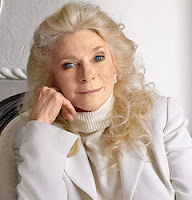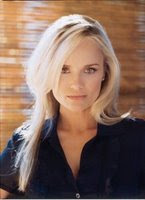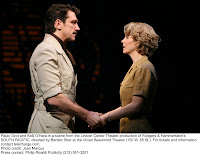
The woman who sang "I've looked at life from both sides now" has finally found what she searched for through years of unforgettable music and profound personal challenges. This essay by JUDY COLLINS appears in
Guideposts Magazine.
Grief is a blow that we all face, yet it feels like something we could never be prepared for. It’s a journey through pain. For me that journey began on January 15, 1992. On that cold winter’s day, my son, Clark, my only child, got into his family’s station wagon, ran a hose from the exhaust into the window, started the engine and died of carbon monoxide poisoning. At age 33 he took his life. In the minutes and hours and days that followed, I could not imagine that I would ever see a way out, a way through the grief. I couldn’t see how to live beyond my loss. It was as though time had stopped. Clark was the light of my life—a bright, handsome, creative young man, married, with a four-year-old daughter. Now he was gone, and I could never even begin to understand why.
Throughout my son’s life, he had experienced both great joy and great sorrow. When he gave up drugs and alcohol nearly seven years earlier, I had thought that, for Clark, the worst was over. I rejoiced. Now I couldn’t make sense of why he had killed himself—at least, Why now? But even as I couldn’t exactly grasp why Clark was gone, part of me understood all too well. Suicide is woven into the history of our family. Clark’s paternal grandfather had taken his life too. And as a young girl, I had made an attempt to end mine, so I understood the engulfing despair that brings someone to that desperate edge. But none of this really made sense to me at the time of Clark’s death.
My thoughts and feelings were refracted by my grief. And grief is, above all, a process—oftentimes a desperately hard struggle—one that for me goes on till this day, 17 years later. Yet it has also brought me closer to my faith.
In my book The Seven T’s: Finding Hope and Healing in the Wake of Tragedy, I offer strategies for coping with loss. Here are some of the things I’ve done to deal with my sorrow. It’s my prayer that what I’ve learned will help others too.
1. Write It Down
A month after Clark died, I wrote in my journal, “I will live in the gap, live in the moment between the breaths, in that pause where wings of an angel pass, where the flowers bloom, where love is born out of trouble.” I felt a sense of clarity, of purpose, despite the fact that grieving is a task that requires time, and patience. But love can be born out of trouble.
Journaling and other creative outlets were crucial to my healing process. I put my thoughts into meditations to get me through the days, trusting that, at least when I was writing, I would continue to breathe and to think. One day I wrote, “My granddaughter is learning to dance. I bought her gold slippers and she is getting very tall. She seems to be healing, like a tall blond flower in a garden, growing in spite of her loss.” I had again begun to trust in the joy of seeing a child who was of my flesh and blood develop into a beautiful young girl, a reminder of her father, yes, but a total person in her own right. I began to trust in her ability to help heal me as well. Journaling offers both intimacy and freedom. You can write whatever you want and it can be incredibly cathartic.
2. Make Time for Your Friends
A gentle snow drifted over the bare branches of century-old trees and hovered over the New York skyline. It softened the outlines of cars coming down Fifth Avenue, trying not to skid on the fast-whitening street surfaces. I made my way from the taxi, tall boots with pointed toes and high heels, taking chances on the ice that lay under the soft cover. I had a date for coffee with an old friend, Isabel, who had also lost her son years before. Her loss, like mine, was unexpected and tragic. Over coffee in the tearoom of a midtown hotel, I tried to tell as much of the truth as I could to my friend. I wanted what she had—grace under pressure, valor amid difficulty.
“Did you love him?” she asked me gently. I told her that I had loved him beyond all imagining. “And did he love you?” I said yes, that Clark had loved me. “Then it is all right,” she said. In Isabel’s trusted company, I could take one step forward while the snow continued to fall outside. Make time for your friends as you embark on the grieving process—they will help you find your grace and valor; they will help carry you through.
3. Pray
We all grieve in our own ways. I believe that there are certain things that can truly help anyone. Prayer works—for oneself, and for others. It is powerful. I meditate and pray daily and give thanks for all of the people in my life. You must ask others to pray for you too. I have a friend, Lorna Kelly, who became a devotee of Mother Teresa, and spent a number of years visiting the Sisters of Charity in Calcutta, India. There, Lorna would work alongside the sisters and talk often with Mother.
After Clark’s death, Lorna was making another trip to visit Mother Teresa. She asked me for a photograph of Clark. In Calcutta, Mother asked about Clark, about his life and his death, and Lorna, who had known my son, told her all about him and gave Clark’s photograph to her. Mother Teresa put Clark’s photograph into the back of the Bible she always carried with her, telling Lorna that she would pray for him. And for me. This loving gesture gave me so much comfort. What if each of us were to make a gesture like that, say, just once a month, toward a total stranger? I like to think that the world would slowly shift away from the dark and toward the light. Prayer is that powerful.
4. Take Care of Yourself
People who are grieving often get physically ill—as though their heartsickness takes over their entire being. I know it’s difficult to focus on yourself when the loved one you have lost is foremost in your heart and mind. But, please try. Eat good, healthy food, don’t skip your exercise, get plenty of fresh air. Take long walks. Above all, be patient and gentle with yourself.
As soon as you can, get back to your work. I know that’s hard. I wanted to curl up in a ball and lock myself away. But I got a call from a dear friend who had also lived through a sudden and devastating loss. “Don’t cancel all your plans,” she said. “Keep working. Do what you love. If you don’t, you won’t heal.” She was right. It wasn’t easy getting back to performing and recording, but I did it, and now I’m so grateful. It helped me to stay engaged with other people and took me outside of myself. God, I believe, gives us work so that we can remain teachable. There is no education quite like working, doing the things that have been given to you to do, using the talents you have been blessed with and work on to improve.
5. Remember
The memories of your loved one may be painful, terribly painful, at first. But in the long run, they are going to help you recover, rejuvenate your inner life and take you to the new place that now beckons in the aftermath of tragedy. Treasure your memories; they are your friends. They will help to heal you. My son had red hair and a quick smile and loved to fish, to sing and to read. How I miss his smile, like sunlight, and his silliness. I miss his deep laughter and his joy at playing the guitar for me. I miss his quicksilver intelligence and his humor. I remember his enthusiasm for his family, for his work, for the band he played in, for the comic strips of Erik Larsen.
I recall his kindness to strangers, the joy he felt about living in Minnesota, his pleasure in thriving in the cold weather, wearing the furry hat that covered his ears. I miss his voice on the telephone, his face in the window, his figure at the end of the ramp at the airport, smiling and greeting me with open arms. Your loved one is alive in the details. Record them in your mind or on paper, wherever you can. It is through the treasuring of these small facts that we keep the people we have loved close to our hearts.
6. Have Faith in Your Faith
Not long after Clark died, I walked the 20 or so cold city blocks from my apartment to the Cathedral of St. John the Divine. It has long been a meaningful place in my life. It’s where my husband, Louis, and I were married, and where Clark, right there on the cathedral steps, experienced the epiphany that led him to sobriety. I was very close to Reverend Morton, the dean of the cathedral, and instinctively knew that I could talk to him whenever I needed to. He listened. And he cried with me.
Have faith in your faith. It will comfort you in the toughest of times. When I lost Clark, I did have faith—but it was conditional and unchallenged. I had to relearn the faith of my childhood, the faith of my unconscious moments, the faith that helps me sleep at night, that keeps my body breathing and functioning and healing. I had to trust that faith, knowing that God would always be there for me, and indeed was already with me—in churches and fields, in songs, in nature, in my heart. He was on every step of my journey from my tragic loss to ever deeper healing.




















